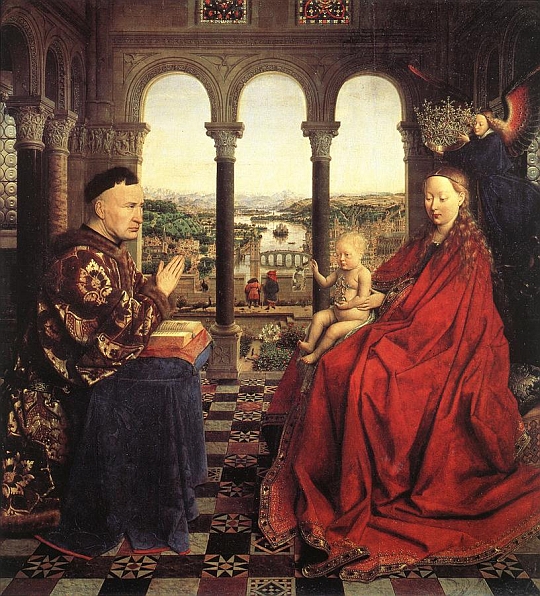
Maximo autem, cui minimum coincidit, convenit ita unum
amplecti, quod et aliud non dimittat, sed simul omnia. Quapropter
natura media, quæ est medium connexionis inferioris et superioris,
est solum illa, quæ ad maximum convenienter elevabilis est potentia
maximi infiniti Dei. Nam cum ipsa intra se complicet omnes naturas,
ut supremum inferioris et infimum superioris, si ipsa secundum omnia
sui ad unionem maximitatis ascenderit, omnes naturas ac totum universum
omni possibili modo ad summum gradum in ipsa pervenisse
constat.
Humana vero natura est illa, quæ est supra omnia Dei opera
elevata et paulo minus angelis minorata, intellectualem et sensibilem
naturam complicans ac universa intra se constringens, ut microcosmos
aut parvus mundus a veteribus rationabiliter vocitetur. Hinc
ipsa est illa, quæ si elevata fuerit in unionem maximitatis, plenitudo
omnium perfectionum universi et singulorum existeret, ita ut in ipsa
humanitate omnia supremum gradum adipiscerentur.
Now, it befits the Greatest, and coincidentally also the Smallest, to embrace one thing in such way that it does not repel another thing but rather reconciles them. Therefore, a middle nature, which is the medium of conjunction of the lower and the higher, is alone that which properly can be raised to the Highest by the power of the great and infinite God. For since it unfolds itself in all natures, namely as highest of the lower form as well as the lowest of the higher form: and thus it is clear that within it lies the capacity for all natures, and the totality of the universe in every possible form up to the highest stage, as it rises up in accordance with its orientation towards unity with the Greatest.
However human nature, though a little beneath that of the angels, is elevated above all other works of God; it enfolds intellectual and perceptive faculties and encloses all things within itself, so that the ancients were right to call it a microcosm, or
small world. Hence, human nature is filled with a longing for unity with the Greatest, a striving for perfectibility of the universe and of all individual things, all in order that humanity may ultimately reach the highest stage.
—Niclas Krebs, later Cardinal Nicholas of Kues, De docta ignorantia, lib. iii, cap. iii (1440) in: Nikolaus von Kues’ philosophisch-theologische Werke in deutscher und lateinischer Sprache, vol. 1/iii, pp. 18-21 (S.H. transl.)
At the core of the values of the early Renaissance was the notion of the human individual and the cosmos; these ideas are generally tied to the great humanists of the Quattrocento such as Petrarch or Pico della Mirandola. But Ernst Cassirer and Erwin Panofsky saw the same concepts expressed in the paintings of Jan van Eyck and his contemporary, the theologian and philosopher Nicholas of Kues or Cusanus, and both specifically cite the masterpiece The Madonna of Chancellor Rolin as a prime example. In Die Kunst der Künste (1999), Anita Albus has provided a detailed development of the Cassirer-Panofsky thesis, drawing on this passage from Cusanus and carefully reviewing the construction of the van Eyck masterpiece. “The wounding recognition that the earth was not the center of the universe was compensated for by the enhanced status of the individual,” Albus writes in her discussion of van Eyck, quoting Cusanus. “The equivalence of every point of view corresponds to the continuum of space.” The American art historian Clifton Olds has made similar arguments.


